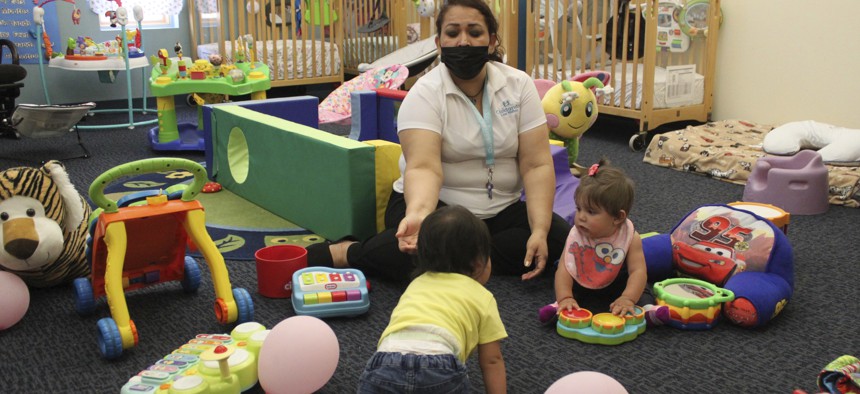How State and Local Leaders Can Bolster a Core American Ideal

This May 2021 photo shows a teacher working with two infants at Cuidando Los Ninos in Albuquerque, N.M. The charity provides housing, child care and financial counseling for mothers. AP Photo/Susan Montoya Bryan
COMMENTARY | Programs focused on preventing childhood trauma could go a long way towards delivering on the idea that the "pursuit of happiness" is an unalienable right.
Perhaps the least defined ideal written into our Declaration of Independence is that the “pursuit of happiness” is an unalienable right.
Little exists to define Thomas Jefferson’s intention including this statement; there is no written documentation about his thinking in any of his official correspondence, nor in the writings by any of the other 56 delegates who signed the document.
So, in the data-driven age in which we live, how might we measure happiness? Is it even possible? And, importantly for policymakers, how does the concept link back to the social safety net programs governments provide and the taxes Americans pay?
Two Statistics to Consider
A couple years ago, while doing some research, I found two interesting, surprising and, I believe, related numbers.
Here’s the first. Based on some estimates, around 21% of our population receives safety net subsidies of $20,000 or more per year excluding people who are Social Security and Medicare beneficiaries. That’s our first number, 21%.
The second figure is based on what’s known as the adverse childhood experiences, or ACE score. This metric, based on a short quiz, attempts to capture the amount of trauma a person experiences prior to reaching age 18.
Traumas reflected in an ACE score include events like physical, sexual, and verbal abuse; physical and emotional neglect; a family member who was depressed, diagnosed as mentally ill, or addicted to alcohol or another substance.
(You can learn more about this assessment and get your own score here from the American Society for the Positive Care of Children.)
Here’s something notable about your ACE score: The higher it is, the more likely you’re at risk of health and social problems, and ultimately having a shorter life than someone with a lower score.
For a person with an ACE score of 4, the odds of having chronic pulmonary lung disease go up 390% compared to the baseline of zero. They would also have a 460% greater chance of depression, and their estimated chances of suicide are elevated over 1,000%.
The higher a person is on the 10-point scale, the higher rates of heart disease, cancer, diabetes, Alzheimer’s, poverty, incarceration, homelessness, and substance abuse.
So, here are the two surprisingly similar numbers. Recall that 21% of adults in the U.S. rely on $20,000 or more per year in safety net subsidies. At the same time, 22% of adults have three or more ACEs.
I know that correlation does not prove causation. But, we know that people who experience significant trauma in childhood are far more likely to struggle later in life. I would go so far as to use a stronger word than struggle, and that word is suffer.
Tying it Back to Policy Making
It’s very hard to pursue happiness under the burden of adverse childhood experiences. It is possible, but the odds are stacked against you.
Why does this all matter for state and local leaders? If the pursuit of happiness is really one of our core beliefs as Americans, then perhaps we need to ask more questions about what we can do to prevent or detect the trauma our children experience.
Doing so could increase the chances for a happier life by all those who benefit.
At the same time, public investments aimed at reducing childhood trauma are proactive and aimed at avoiding bad outcomes for people later in life, before they happen.
That’s in contrast to the reactive approach with many safety net programs that seek to help people with health and economic difficulties once they’ve already set in.
In other words, spending on programs that could help to alleviate childhood trauma has the potential to not only bring the nation closer to achieving one of its core ideals, it could also be a much smarter way to use public dollars.
John M. Bernard is the author of Government That Works, The Results Revolution in the States. His podcast The New Bureaucrat features leaders in state government who are working to transform the effectiveness and efficiency of state government.
NEXT STORY: Pandemic Sweetens Lure of Smaller Cities’ Relocation Incentives





